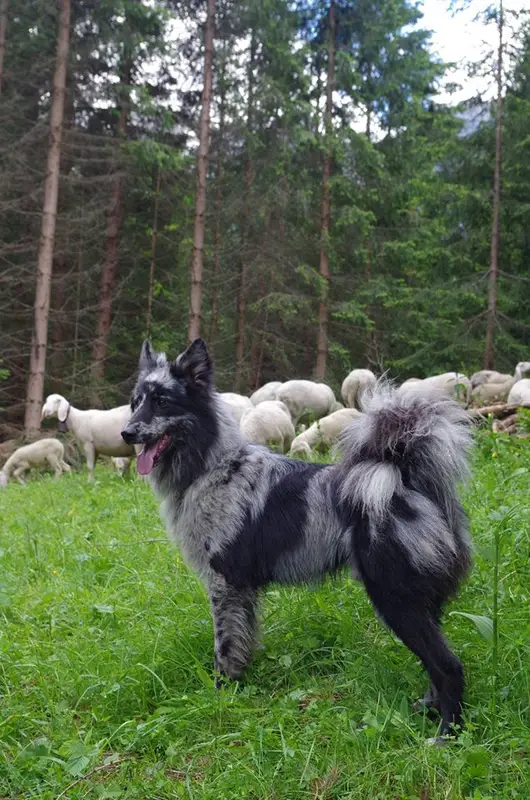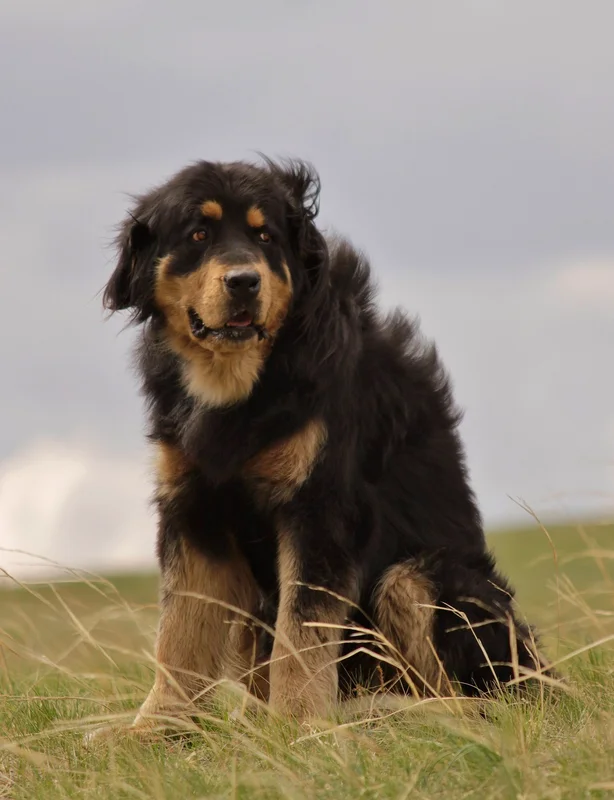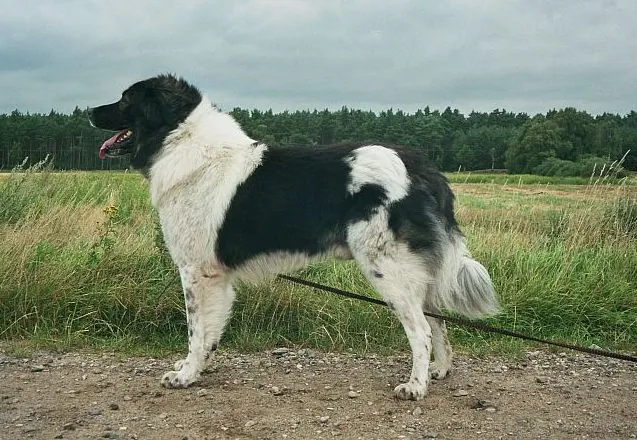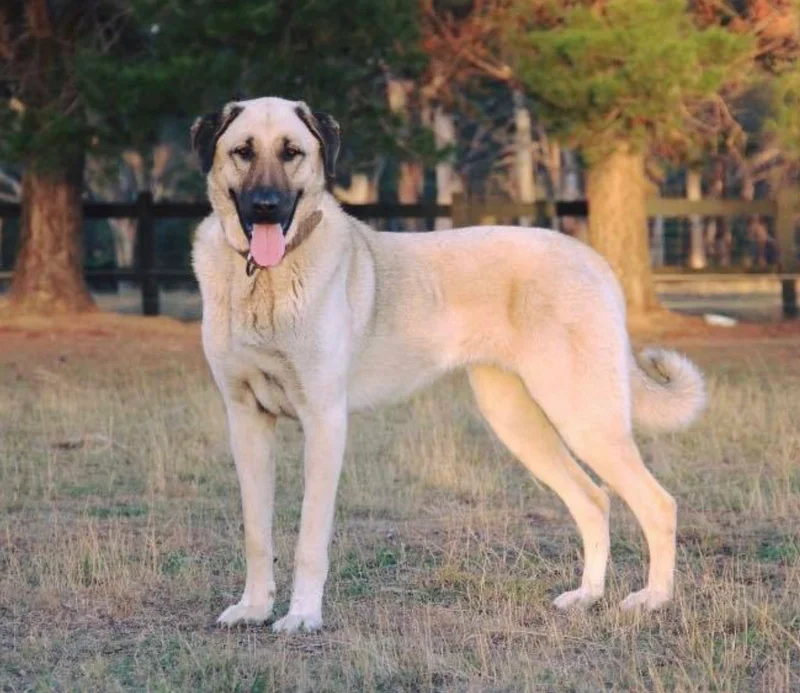Maremmano-Abruzzese Sheepdog
The Maremmano-Abruzzese Sheepdog is a large, intelligent breed known for its protective instincts and loyalty. Originating from Italy, they excel as livestock guardians and make devoted companions in rural settings.
Overview
🐕Breed Overview
✨Key Traits
💡What Makes Maremmano-Abruzzese Sheepdog Special
The Maremmano-Abruzzese Sheepdog is distinguished by its impressive size and striking white coat, which serves as a visual deterrent to predators. Their natural guarding instincts make them excellent protectors of livestock, and they are known for their ability to work independently, often left alone with their charges for extended periods.
This breed is highly intelligent, capable of problem-solving and adapting to various situations. Their calm demeanor and gentle nature with children make them suitable family companions, provided they have enough space to roam.
Maremmas require consistent training and socialization to manage their protective instincts and ensure they are well-adjusted in social settings. Their strong territorial nature means they thrive in rural environments where they can fulfill their instinctual roles as guardians.
The Maremmano-Abruzzese Sheepdog, known for its impressive stature and striking white coat, is a breed deeply rooted in the pastoral traditions of Italy. Originating from the Abruzzo region and the Maremma marshlands, these dogs have served as loyal guardians of sheep flocks for centuries, protecting them from predators like wolves. With a solid, muscular build and a calm, intelligent demeanor, the Maremma is not only a formidable protector but also a loving companion for families with ample space.
Their history is rich, with references to similar dogs found in ancient Roman literature, showcasing their long-standing role in agriculture. Despite their independent nature, Maremmas form strong bonds with their families and are known for their gentle interactions with children. However, their protective instincts can lead to wariness towards strangers, making early socialization essential.
This breed thrives in rural environments where they can roam freely and engage in their natural guarding behaviors. With proper training and socialization, the Maremmano-Abruzzese Sheepdog can adapt to family life while fulfilling its instinctual roles as a protector and companion. Their unique combination of loyalty, intelligence, and independence makes them a remarkable breed for those who appreciate their heritage and capabilities.
🎉Fun Facts
Maremmas are often used in conservation efforts, helping to protect endangered species like penguins in Australia.
The Maremmano-Abruzzese Sheepdog is known for its impressive ability to bond with livestock, often sleeping among them for protection.
Their thick double coat provides insulation against harsh weather, making them well-suited for outdoor living.
These dogs have been depicted in art and literature since ancient Roman times, showcasing their long-standing role in agriculture.
Breed Characteristics
Family & Friends
Good Behavior
Get Up & Go
Household Harmony
Temperament & Personality
✨Key Traits
🐕Core Temperament
The Maremmano-Abruzzese Sheepdog exhibits a temperament that is both protective and gentle. They are known for their loyalty to their families and livestock, displaying a calm demeanor that belies their imposing size.
While they are affectionate with their loved ones, they can be wary of strangers, making early socialization essential to ensure they are well-adjusted. Their independent nature allows them to work autonomously, which is crucial for their role as livestock guardians.
Maremmas are generally good with children, displaying patience and gentleness, but supervision is recommended due to their size and strength. Their protective instincts make them excellent watchdogs, but they require consistent training to manage their territorial behaviors.
💫Personality Profile
The Maremmano-Abruzzese Sheepdog is a breed characterized by its loyalty and protective instincts. They are known to form strong bonds with their families and livestock, displaying a calm and intelligent demeanor.
While they can be affectionate with their loved ones, they tend to be wary of strangers, making early socialization crucial. Their independent nature allows them to work autonomously, which is essential for their role as livestock guardians.
Maremmas are generally good with children, displaying patience and gentleness, but supervision is recommended due to their size and strength. They thrive in environments where they can patrol and protect, making them less suitable for urban living.
🔊Vocal Tendencies
The Maremmano-Abruzzese Sheepdog is known for its vocal nature, often barking as part of its guarding duties. They may bark to alert their owners of potential threats or when they perceive something unusual in their environment.
While this behavior is instinctual, it can be problematic in urban settings where noise restrictions may apply. Their barking is typically deep and resonant, and they may also express themselves through growls or howls when interacting with other animals or during play.
Owners should be prepared for their vocalizations and consider training to manage excessive barking if necessary.
Affection & Social Traits
Energy & Activity
Communication Style
Care Requirements
🏃♂️Exercise Requirements
Daily Exercise
The Maremmano-Abruzzese Sheepdog requires a moderate amount of exercise to maintain its physical and mental well-being. Ideally, they should engage in at least 60 to 90 minutes of exercise daily, which can be broken down into multiple sessions. Activities such as long walks, running, and playtime in a secure area are beneficial.
Given their history as livestock guardians, they thrive in environments where they can roam freely and patrol their territory. Puppies should have shorter, more frequent exercise sessions to avoid overexertion, while senior dogs may require gentler activities to accommodate their energy levels. Regular exercise not only helps manage their weight but also reduces the likelihood of behavioral issues stemming from boredom or pent-up energy.
Insufficient exercise can lead to destructive behaviors, anxiety, and an increased risk of obesity, making it crucial for owners to prioritize their exercise needs.
Preferred Activities
🏠Living & Adaptability
Space Requirements
The Maremmano-Abruzzese Sheepdog requires ample space to thrive, making them unsuitable for apartment living. They do best in rural or suburban environments with large yards or open land where they can roam and patrol.
Ideally, they should have access to a secure outdoor area where they can engage in physical activities and express their natural guarding instincts. Owners in smaller spaces should ensure regular trips to parks or open fields to meet their exercise and socialization needs.
The breed's size and energy level necessitate a living environment that allows for freedom of movement; otherwise, they may exhibit signs of frustration or anxiety.
Climate Preference
🍲Feeding Guide
Schedule
Food Types
Portion Size
Special Nutritional Needs
Maremmano-Abruzzese Sheepdogs require a balanced diet rich in protein to support their muscular build and active lifestyle. It's important to choose high-quality dog food that meets their nutritional needs, particularly during their growth stages as puppies.
Some dogs may have sensitivities to certain ingredients, so monitoring their reactions to new foods is essential. Regular veterinary check-ups can help determine if any dietary adjustments are necessary.
✨Grooming Requirements
Grooming Overview
The Maremmano-Abruzzese Sheepdog has a thick, long coat that requires regular grooming to keep it healthy and free of mats. Brushing should be done at least once a week, with more frequent grooming during shedding seasons to manage loose hair.
Use a slicker brush or a comb to remove tangles and prevent matting. Bathing should be done as needed, typically every few months, or when the dog becomes particularly dirty.
Regular nail trimming and ear cleaning are also important aspects of their grooming routine to maintain overall hygiene and health.
Care Schedule
Brush weekly; bathe every 2-3 months; trim nails every 2-4 weeks.
Health Profile
⚕️Health Care
Regular health care is crucial for the Maremmano-Abruzzese Sheepdog's longevity. Routine veterinary check-ups, vaccinations, and preventive treatments can help detect and address health issues early.
Maintaining a balanced diet, providing regular exercise, and ensuring proper dental care are also important aspects of their health management. Owners should be proactive in monitoring their dog's health and addressing any concerns promptly to promote a long and healthy life.
Health Issues Overview
⏳Average Lifespan
Genetic Factors
Genetics play a significant role in the lifespan of the Maremmano-Abruzzese Sheepdog. As a breed, they may be predisposed to certain hereditary health issues, such as hip dysplasia and hypothyroidism.
Responsible breeding practices that prioritize genetic diversity and health testing can help mitigate these risks. Potential owners should seek reputable breeders who conduct health screenings and provide transparency regarding the lineage of their puppies.
Living Conditions
The Maremmano-Abruzzese Sheepdog's lifespan can be influenced by various environmental factors, including living conditions, climate, and social interactions. Dogs that live in spacious, rural environments with access to outdoor activities tend to have longer, healthier lives.
Exposure to harsh weather conditions can also impact their health, so providing adequate shelter and care is essential. Additionally, social interactions with humans and other animals can contribute positively to their mental well-being, reducing stress and anxiety, which can otherwise shorten their lifespan.
🏥Common Health Issues
Hip Dysplasia
Warning Signs
🔬Diagnosis
Veterinarians typically diagnose hip dysplasia through physical examinations and X-rays.
💊Treatment
Treatment options include weight management, physical therapy, and in severe cases, surgical intervention.
📝Management Tips
Maintain a healthy weight, provide joint supplements, and engage in low-impact exercise to reduce stress on the joints.
Progressive Retinal Atrophy (PRA)
Warning Signs
🔬Diagnosis
Diagnosis is made through veterinary eye examinations and genetic testing.
💊Treatment
Currently, there is no cure for PRA; management focuses on adapting the environment to the dog's needs.
📝Management Tips
Regular veterinary check-ups and monitoring for vision changes are essential.
Hypothyroidism
Warning Signs
🔬Diagnosis
Diagnosis is typically made through blood tests measuring thyroid hormone levels.
💊Treatment
Treatment usually involves lifelong thyroid hormone replacement therapy.
📝Management Tips
Regular monitoring and medication can help manage the condition effectively.
🛡️Preventive Care
🔬Hip Evaluation
This test assesses the dog's hip joints for dysplasia, a common condition in large breeds.
📅 Recommended at 12 months and regularly thereafter, especially for breeding dogs.
🔬Thyroid Function Test
A blood test that measures thyroid hormone levels to detect hypothyroidism.
📅 Annual testing is recommended, especially for older dogs.
🔬Ophthalmic Examination
An eye examination by a veterinary ophthalmologist to check for hereditary eye conditions.
📅 Recommended every 1-2 years, especially for breeding dogs.
Training
🧠Intelligence & Trainability
💪Work Drive
The Maremmano-Abruzzese Sheepdog has a strong work drive, stemming from its history as a livestock guardian. These dogs thrive when given tasks to perform, whether it's patrolling their territory or engaging in herding activities.
Providing them with a job, such as guarding livestock or participating in agility training, can help fulfill their need for mental and physical stimulation. Without adequate engagement, they may become bored and exhibit undesirable behaviors.
Owners should aim to incorporate structured activities into their daily routine to keep their Maremma mentally sharp and physically active.
⚠️Training Considerations
Maremmano-Abruzzese Sheepdogs can exhibit behavioral challenges, particularly if not properly socialized from a young age. Their natural guarding instincts may lead to wariness or hostility towards strangers, making early exposure to various people and environments essential.
Additionally, their independent nature can result in stubbornness during training sessions. To overcome these challenges, consistent and positive reinforcement training methods are recommended.
Engaging them in obedience training and socialization classes can help mitigate their protective tendencies and foster a well-rounded temperament. Owners should also be prepared to provide mental stimulation through interactive toys and activities to prevent boredom-related behaviors.
📝Training Tips
Training a Maremmano-Abruzzese Sheepdog requires patience and consistency. Start with basic obedience commands, using positive reinforcement techniques such as treats and praise to encourage desired behaviors.
Socialization is crucial; expose them to different environments, people, and other animals to help them become well-adjusted adults. Incorporate mental challenges, such as puzzle toys or scent work, to keep their minds engaged.
Given their independent nature, training sessions should be kept short and enjoyable to maintain their interest. Establishing a strong bond with the dog through regular interaction and play will enhance their responsiveness to training.
History & Heritage
📜Origin Story
The Maremmano-Abruzzese Sheepdog, known for its striking white coat and imposing stature, hails from the picturesque regions of Abruzzo and the Maremma marshlands in Italy. This breed's history is intertwined with the pastoral lifestyle of Italian shepherds, who relied on these dogs for centuries to protect their sheep from wolves and other predators.
The name itself translates to 'the dog of the shepherds of the Maremma and Abruzzese region,' reflecting its deep-rooted connection to the land and its people. Ancient Roman texts describe similar dogs, highlighting their long-standing role in agriculture.
As sheep farming evolved, so did the Maremmano-Abruzzese, adapting to the changing needs of shepherds while maintaining its natural guarding instincts. Today, these dogs are not only a symbol of Italian heritage but also a testament to the enduring bond between humans and their canine companions in the rural landscape.
⏳Development History
The Maremmano-Abruzzese Sheepdog's origins can be traced back to ancient times, with references to similar white livestock guardian dogs found in Roman literature. Over the centuries, these dogs were selectively bred for their protective instincts and ability to bond with livestock.
The breed was officially recognized in the early 20th century, with the first breed standard established in 1924. Despite being regarded as two separate breeds until 1958, the Maremmano and Abruzzese types were unified due to their shared characteristics and historical significance.
Today, the breed remains a crucial asset for shepherds in Italy and has gained popularity as a livestock guardian in other countries, including Australia and the United States.
🛡️Purpose & Historical Role
Traditionally, the Maremmano-Abruzzese Sheepdog was bred as a livestock guardian, tasked with protecting sheep flocks from wolves and other predators. Their role was primarily one of deterrence, using their size and presence to dissuade threats rather than engaging in direct combat.
This breed's ability to work independently, often left alone with the flock for extended periods, showcases their intelligence and strong territorial instincts. Over time, they have also been utilized in various capacities, including as family companions and watchdogs, adapting to the needs of modern households while retaining their protective nature.
🏺Cultural Significance
The Maremmano-Abruzzese Sheepdog has deep roots in Italian culture, particularly in the regions of Abruzzo and Tuscany. Historically, these dogs have been integral to the pastoral lifestyle, serving as guardians of sheep flocks against predators like wolves.
Their presence is not only a practical necessity for shepherds but also a symbol of the rich agricultural heritage of central Italy. The breed is celebrated in local folklore and art, often depicted alongside shepherds in various historical artworks.
Their role in maintaining the balance between livestock and wildlife has made them a vital part of rural communities, and they continue to be revered for their loyalty and protective instincts.
Conservation Status
This breed is less common but has stable populations in certain regions.









